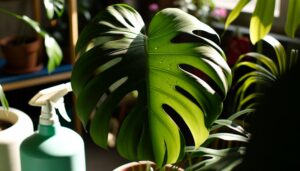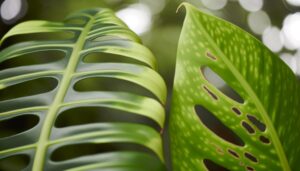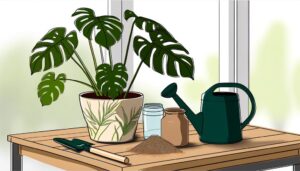Monstera Pinnatipartita Young
As a young Monstera pinnatipartita, you'll find its thick, leathery leaves captivating, though they haven't yet developed the deep fenestrations typical of mature plants. Native to Central and South America, this Araceae family member thrives in bright, indirect light and at least 60% humidity.
Make sure it has well-draining soil rich in organic matter, good airflow, and temperatures between 18-27°C (64-81°F). Water deeply, allowing the top inch of soil to dry out, and use a balanced, water-soluble fertilizer bi-weekly.
Prevent root rot and pests like spider mites and mealybugs. To learn more about nurturing and propagating this tropical beauty, continue here.
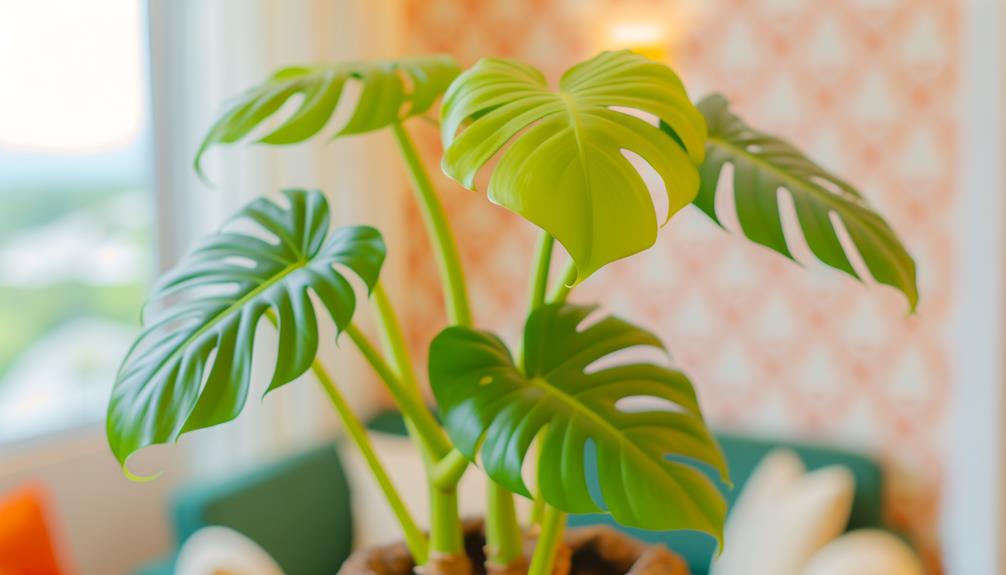
Key Takeaways
- Young Monstera Pinnatipartita leaves are less fenestrated compared to mature leaves.
- They require a humidity level of at least 60% to thrive.
- Bright, indirect light is ideal for the healthy growth of young plants.
- Ensure soil is well-draining and rich in organic matter.
- Propagate using stem cuttings with at least one node for best results.
Origin and Characteristics

Originating from the tropical rainforests of Central and South America, Monstera pinnatipartita exhibits deeply fenestrated leaves that evolve as the plant matures.
You'll observe that juvenile leaves are smaller, solid, and elliptical. As the plant ages, the leaves develop extensive perforations and lobes, a characteristic known as fenestration. This adaptation likely maximizes light capture and minimizes wind resistance in its native understory habitat.
The thick, leathery texture of the leaves helps reduce water loss, essential for survival in its humid environment. Monstera pinnatipartita belongs to the Araceae family, characterized by its climbing habit, which it accomplishes via aerial roots.
These roots anchor the plant to trees, enabling it to ascend towards the canopy light. Understanding these features aids in appreciating its natural beauty and complexity.
Ideal Growing Conditions
To thrive, Monstera pinnatipartita demands a humid setting with consistent temperatures ranging between 18°C to 27°C (64°F to 81°F). Replicating its native tropical rainforest habitat for ideal growth conditions is important.
You'll need to provide:
- Humidity: Maintain at least 60% relative humidity to prevent leaf desiccation.
- Light: Indirect, bright light is essential; avoid direct sunlight to prevent leaf scorch.
- Soil: Use well-draining, aerated soil with organic matter, such as a mix of peat, perlite, and orchid bark.
- Air Circulation: Ensure good airflow to reduce the risk of fungal infections and pests.
Monitoring these factors will help you create a favorable environment for Monstera pinnatipartita's vigorous growth and impressive fenestration.
Watering and Feeding
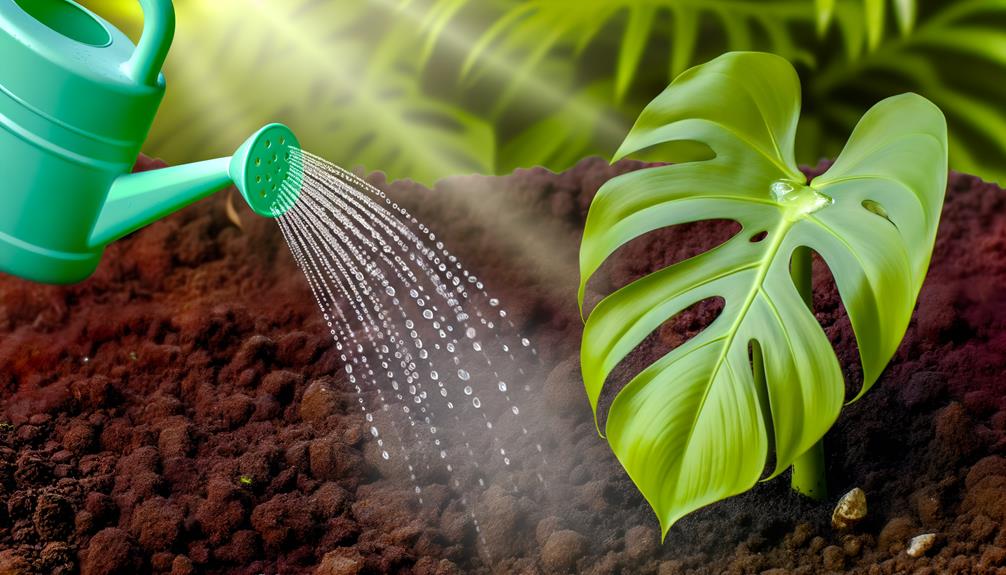
Regularly, you should water Monstera pinnatipartita deeply but allow the top inch of soil to dry out between waterings to prevent root rot. This balance ensures best hydration without promoting fungal pathogens. For feeding, use a balanced, water-soluble fertilizer (20-20-20) during the growing season. Apply it bi-weekly at half strength to avoid nutrient burn.
| Aspect | Frequency | Details |
|---|---|---|
| Watering | Every 5-7 days | Deep watering; top inch soil dry |
| Soil Moisture | Regular checks | Top inch should be dry |
| Fertilizing | Bi-weekly in growing season | 20-20-20 fertilizer, half strength |
| Feeding Volume | Moderate | Avoid over-fertilization |
| Seasonal Adjustments | Less in winter | Reduced watering and fertilizing |
Monitoring these parameters helps your Monstera pinnatipartita thrive.
Common Issues
Despite meticulous watering and feeding practices, Monstera pinnatipartita can still encounter several common issues, such as yellowing leaves, root rot, and pest infestations.
Yellowing leaves often result from chlorosis due to nutrient deficiencies or improper light exposure. Root rot, caused by pathogens like Pythium or Phytophthora, stems from overwatering or poor drainage. Pest infestations, including spider mites (Tetranychus urticae), mealybugs (Pseudococcidae), and scale insects, can damage leaves and hinder growth.
- Chlorosis: Yellowing due to iron or magnesium deficiencies.
- Root rot: Fungal infections leading to mushy roots.
- Spider mites: Tiny arachnids causing stippling and webbing.
- Mealybugs: White, cotton-like insects secreting honeydew.
Understanding these issues will help you take proactive measures to maintain plant health.
Propagation Methods
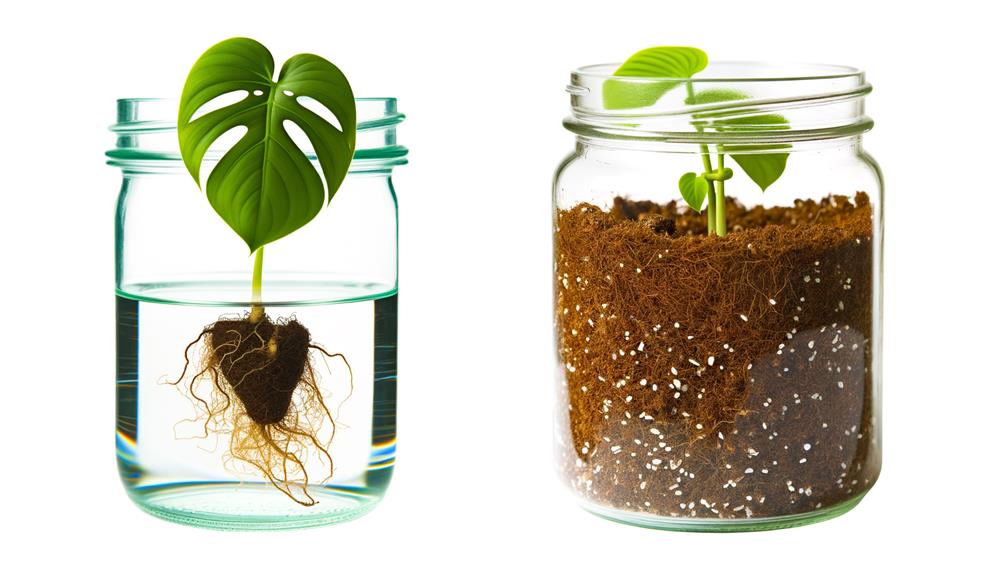
Propagating Monstera pinnatipartita primarily involves stem cuttings. When placed in a well-draining medium under ideal humidity and temperature conditions, these cuttings develop roots. To start the process, select a healthy stem with at least one node and a couple of leaves. Using sterilized pruning shears, make a clean cut below the node. Dip the cut end in rooting hormone (auxins like indole-3-butyric acid) to enhance root development.
Place the cutting in a mix of peat and perlite, maintaining a humidity level around 70-80%. It's crucial to keep the temperature between 20-25°C (68-77°F). Regularly mist the cutting and ensure it receives appropriate light exposure. Within a few weeks, roots should begin to emerge, signaling successful propagation. Once the cutting has rooted, transfer it to a larger pot as it continues to grow.
Conclusion
In nurturing your Monstera pinnatipartita, remember to maintain a balance between care and attention. Keep its environment just right with bright, indirect light and a humidity boost.
Don't overdo watering, as you wouldn't want it to take an unforeseen nap. Regular feeding will promote robust growth, while propagation by stem cuttings guarantees continuity.
Address common issues promptly to keep your Monstera thriving. With these guidelines, you're set to enjoy a flourishing, healthy plant.


